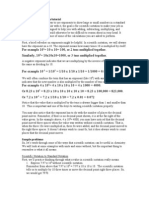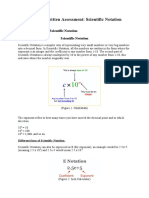0 ratings0% found this document useful (0 votes)
33 viewsStandard Form
Standard Form
Uploaded by
Sarah SrhThe document discusses why standard form is useful when dealing with very large or very small numbers, which are common in science and engineering work. It would save time to use standard form instead of writing out long strings of zeros when working with things like particle sizes, bank accounts, virus contamination levels, or distances in outer space.
Copyright:
© All Rights Reserved
Available Formats
Download as PPTX, PDF, TXT or read online from Scribd
Standard Form
Standard Form
Uploaded by
Sarah Srh0 ratings0% found this document useful (0 votes)
33 views6 pagesThe document discusses why standard form is useful when dealing with very large or very small numbers, which are common in science and engineering work. It would save time to use standard form instead of writing out long strings of zeros when working with things like particle sizes, bank accounts, virus contamination levels, or distances in outer space.
Original Description:
uses of standard form in our daily lives
Copyright
© © All Rights Reserved
Available Formats
PPTX, PDF, TXT or read online from Scribd
Share this document
Did you find this document useful?
Is this content inappropriate?
The document discusses why standard form is useful when dealing with very large or very small numbers, which are common in science and engineering work. It would save time to use standard form instead of writing out long strings of zeros when working with things like particle sizes, bank accounts, virus contamination levels, or distances in outer space.
Copyright:
© All Rights Reserved
Available Formats
Download as PPTX, PDF, TXT or read online from Scribd
Download as pptx, pdf, or txt
0 ratings0% found this document useful (0 votes)
33 views6 pagesStandard Form
Standard Form
Uploaded by
Sarah SrhThe document discusses why standard form is useful when dealing with very large or very small numbers, which are common in science and engineering work. It would save time to use standard form instead of writing out long strings of zeros when working with things like particle sizes, bank accounts, virus contamination levels, or distances in outer space.
Copyright:
© All Rights Reserved
Available Formats
Download as PPTX, PDF, TXT or read online from Scribd
Download as pptx, pdf, or txt
You are on page 1of 6
SARAH, SHELLY, SHAFINA (4SA)
WHY USE IT?
Because it makes it easier when you are dealing with
very big or very small numbers, which are common in
Scientific and Engineering work.
It can also make calculations easier and used a lot in
science
IT WOULD SAVE TIME:
If you work in a technical occupation and deal with
particles that are very small that are used in
semiconductors they would often be expressed as 10 to
some plus or minus number.
If you worked in a bank and had to count large bills and
accounts it could be 1 x 10^ 6 for every million dollars in
the vault for example.
If you worked in the medical profession and had to deal with
contamination of a virus or finding
the purity of water with so many parts per million. The
reduction and use of powers of 10 would be convenient.
Instead of hitting the zero button on your calculator many
times with pencil or finger the power calculation would
definitely save time.
Especially if you went into outer space and had to count
stars.
Or make estimates of particle infiltration in the breathing
mechanisms in use.
These include examples that in real life, the number is
very very large or small. Often it is not practical or
available to store so many digits and a short and
approximated value is more suited.
An example of this is with microcomputer chip
storage. During a program instead of using up
memory spaces with a unreasonable amount of bits
the microprocessor will use standard form in order
to save space and time during processing.
An abstract way of using standard form in real life
could be as follows. Instead of saying I am
1,828.80 millimeters tall you use a more standard
form of 6 feet. 6 feet really is about 6 x 10^4. Using
different units is an abstract way to do this. In
mathematics the example can be translated at
kilometer = 1x10^ -1, meter = 1x10^0, centimeter =
1x10^1, millimeter = 1x10^2.....
Units translate large/small numbers to a more
standard form.
You might also like
- Shop Math PDFDocument29 pagesShop Math PDFKen LeeNo ratings yet
- How Many Licks Or, How To EstimateDocument177 pagesHow Many Licks Or, How To EstimateUmar Jamshed100% (1)
- MathDocument4 pagesMathDALOGDOG, Mary Faith C. 11-AquilaNo ratings yet
- Lesson 1 - Measurements - Conversion of Units, Scientific NotationDocument31 pagesLesson 1 - Measurements - Conversion of Units, Scientific NotationApril Joy Lascuña100% (1)
- Allocation The First Step To CostingDocument1 pageAllocation The First Step To CostingDiego BravoNo ratings yet
- You Be The Chemist Activity GuideDocument4 pagesYou Be The Chemist Activity Guideroh009No ratings yet
- Introduction To PhysicsDocument8 pagesIntroduction To PhysicsNana Ama Donkor-boatengNo ratings yet
- 3-Laboratory and Reporting SkillsDocument97 pages3-Laboratory and Reporting Skillsprod rxckyNo ratings yet
- Physics ReviewerDocument11 pagesPhysics ReviewerAwaawa D orianoNo ratings yet
- Section 1: Safety, Study Skills, and Basic Topics: Lab Safety: in A Small Group, Answer The Following QuestionsDocument11 pagesSection 1: Safety, Study Skills, and Basic Topics: Lab Safety: in A Small Group, Answer The Following QuestionsRippleIllusionNo ratings yet
- Math ToolboxDocument23 pagesMath ToolboxSerdar BALLINo ratings yet
- Scientific Notation Is A Way of Writing Numbers That Is Often Used by Scientists andDocument1 pageScientific Notation Is A Way of Writing Numbers That Is Often Used by Scientists andJFANo ratings yet
- The Marmo Method Modelbuilding Guide #3: Understanding Model Math & Scale JumpingFrom EverandThe Marmo Method Modelbuilding Guide #3: Understanding Model Math & Scale JumpingNo ratings yet
- Foundation Maths For Remote Sensing and Spatial Ecology: The Purpose of These NotesDocument19 pagesFoundation Maths For Remote Sensing and Spatial Ecology: The Purpose of These NotesGeosemsemNo ratings yet
- Unit 2 Math Stations Sig Digits Sci Notation Unit ConversionDocument42 pagesUnit 2 Math Stations Sig Digits Sci Notation Unit Conversionapi-287720908No ratings yet
- 1.4 Expressing Numbers Scientific NotationDocument5 pages1.4 Expressing Numbers Scientific NotationkumarKaushal784No ratings yet
- Scientific Notation TutorialDocument9 pagesScientific Notation TutorialalvinlinlNo ratings yet
- Group 3 1.FURKAN (E1Q011014) 2.ganda Wenang S. (E1Q011015) 3.haerul Muammar (E1Q011016) 4.hardiyanto (E1Q011017) 5.HARI ARFAN (E1Q011018) HILFAN (E1Q011018)Document8 pagesGroup 3 1.FURKAN (E1Q011014) 2.ganda Wenang S. (E1Q011015) 3.haerul Muammar (E1Q011016) 4.hardiyanto (E1Q011017) 5.HARI ARFAN (E1Q011018) HILFAN (E1Q011018)LiaNo ratings yet
- 5S and PpeDocument7 pages5S and PpeLyn VallesNo ratings yet
- Topic NumbersDocument34 pagesTopic NumbersAmanina SulaimanNo ratings yet
- Engineering Calculation Fundamentals: Engr. Calc. Fundamentals Page 1Document24 pagesEngineering Calculation Fundamentals: Engr. Calc. Fundamentals Page 1bauskarm1No ratings yet
- Ccuracy and Speed: HapterDocument14 pagesCcuracy and Speed: HapterCarl ScottNo ratings yet
- Introduction To ModelingDocument20 pagesIntroduction To Modelingoxyde blogyNo ratings yet
- Units and MeasurementsDocument4 pagesUnits and MeasurementsKizrah AragonNo ratings yet
- Mathematical Models in System TheoryDocument7 pagesMathematical Models in System TheorySofiia ZubacNo ratings yet
- Fermi Problems - Definition ExamplesDocument7 pagesFermi Problems - Definition Examplesharshpanwar3000No ratings yet
- Scientific Notation NotesDocument23 pagesScientific Notation NotesCorinne Isabel CastilloNo ratings yet
- Casio Fx-991MS Tips and TricksDocument11 pagesCasio Fx-991MS Tips and TricksSachinKumar100% (1)
- Error Analysis in Experimental Physical Science "Mini-Version"Document10 pagesError Analysis in Experimental Physical Science "Mini-Version"KellyZhaoNo ratings yet
- Physics Lecture On MeasurementsDocument32 pagesPhysics Lecture On MeasurementsLeah ParasNo ratings yet
- Detailed Lesson Plan in Math I. Objectives 1. 2. Show Active ParticipationDocument10 pagesDetailed Lesson Plan in Math I. Objectives 1. 2. Show Active ParticipationGorge RiegoNo ratings yet
- GC General Physics 1Document37 pagesGC General Physics 1justtinxxNo ratings yet
- Physical Science Notes 1Document9 pagesPhysical Science Notes 1Mary Krizette LabellaNo ratings yet
- Concentrations and Dilutions:: A Survival GuideDocument31 pagesConcentrations and Dilutions:: A Survival GuideoldpenguinNo ratings yet
- Spreadsheets and The Data Life CycleDocument11 pagesSpreadsheets and The Data Life CycleKiel RodelasNo ratings yet
- Math Development: Introduction: Mathematic Attainment Levels Can Vary Significantly Amongst Students With DownDocument7 pagesMath Development: Introduction: Mathematic Attainment Levels Can Vary Significantly Amongst Students With DownBig AllanNo ratings yet
- Scientific NotationDocument2 pagesScientific NotationDab Dab litNo ratings yet
- Exp 1a Floating EggDocument3 pagesExp 1a Floating EggKarla PereraNo ratings yet
- Transformations Relating Referent and ModelDocument4 pagesTransformations Relating Referent and ModelBilly Desyanta ManikaNo ratings yet
- Compacted Math 4 Q3W1Document21 pagesCompacted Math 4 Q3W1Heather Burley LaDucaNo ratings yet
- Numerical Solution of Ordinary Differential Equations Part 1 - Intro & ApproximationDocument15 pagesNumerical Solution of Ordinary Differential Equations Part 1 - Intro & ApproximationMelih Tecer100% (1)
- IA SuggestionsDocument2 pagesIA Suggestionsruby.zhou.onNo ratings yet
- Research I Q1 Week 3Document28 pagesResearch I Q1 Week 3Ryle MagaleNo ratings yet
- Architect Term PaperDocument6 pagesArchitect Term Paperafmyervganedba100% (1)
- Transformations Relating Referent and ModelDocument4 pagesTransformations Relating Referent and ModelBilly Desyanta ManikaNo ratings yet
- MST111 Lesson01 03Document55 pagesMST111 Lesson01 03princesjhanelaNo ratings yet
- Lab Manual (PHYS 001)Document36 pagesLab Manual (PHYS 001)AavaNo ratings yet
- Basic Math & ChemistryDocument29 pagesBasic Math & ChemistryLuis Manuel Diaz Guerra67% (3)
- Index Notation and Powers of 10Document6 pagesIndex Notation and Powers of 10Nilo ValeraNo ratings yet
- Metric Measurements Lab - Basic VersionDocument9 pagesMetric Measurements Lab - Basic VersionTeachLABScINo ratings yet
- Data Interpretation-Study Materials Pie ChartDocument3 pagesData Interpretation-Study Materials Pie ChartMukunda Rao Pandit100% (1)
- l3 Final Ross David ColontonioDocument7 pagesl3 Final Ross David Colontonioapi-240041870No ratings yet
- Maths Written AssessmentDocument5 pagesMaths Written AssessmentZackary StewartNo ratings yet
- Unidad 8 Word-Processors, Data Bases, and SpreadsheetsDocument9 pagesUnidad 8 Word-Processors, Data Bases, and SpreadsheetsAndres AmayaNo ratings yet
- c3 Coursework ComparisonDocument4 pagesc3 Coursework Comparisonafjwdudgyodbef100% (2)
- Encyclopedia of StatisticsDocument143 pagesEncyclopedia of Statisticsbedanta87100% (1)
- Golden Ratio HomeworkDocument5 pagesGolden Ratio Homeworkafnadjvaaeivhp100% (1)
- 4 - Decimals - 1Document45 pages4 - Decimals - 1David QianNo ratings yet
- Phy CHP 1Document83 pagesPhy CHP 1Sajjad FaisalNo ratings yet
- Itee ReportDocument15 pagesItee ReportSarah SrhNo ratings yet
- Stanza 1: Literal MeaningDocument3 pagesStanza 1: Literal MeaningSarah SrhNo ratings yet
- Front CoverDocument2 pagesFront CoverSarah SrhNo ratings yet
- Myself ProjectDocument2 pagesMyself ProjectSarah SrhNo ratings yet































































